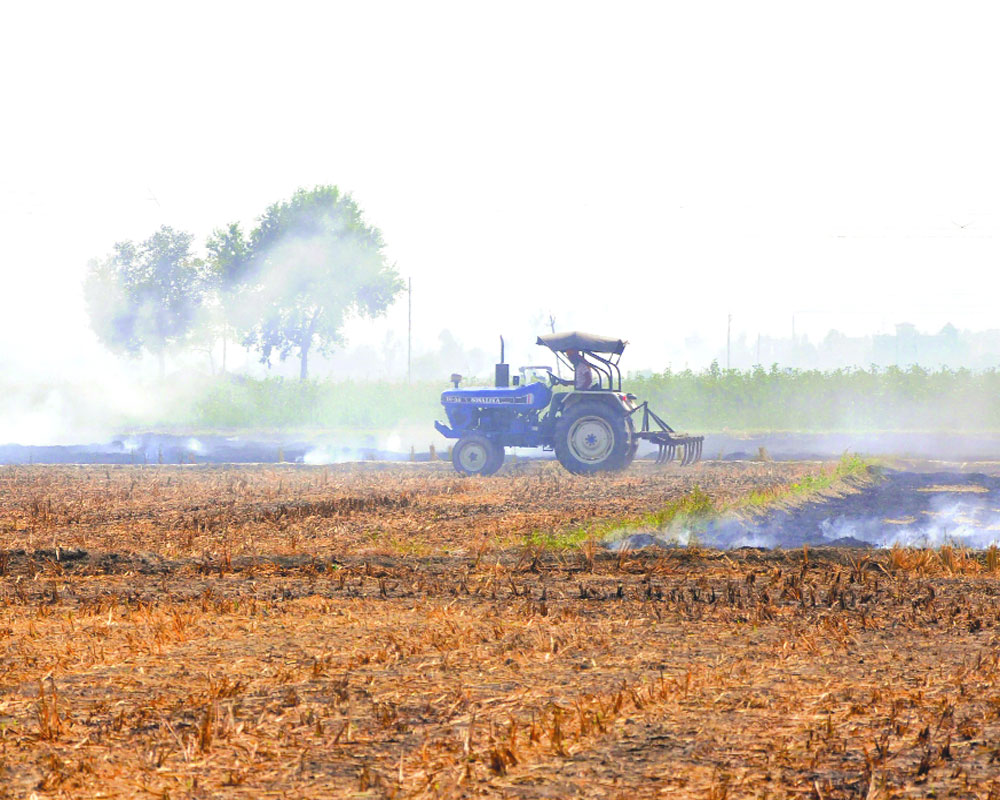Farmers logic to defy ban: Time gap between harvesting too short to await tardy Govt steps
Thick blanket of smog that engulfs the national Capital year after year during winter is clearly visible on the GT Karnal Road connecting Delhi and Karnal in Haryana as it originates from the burning farm stubble and is a major cause of pollution in Delhi-NCR.
Even after the NGT pulled up the State Governments and Haryana came up with an alternative solution, stubble burning is continuing unabated in Haryana and Delhi stares at another winter covered in a cloud of pollutants triggered by the biomass burning.
The Pioneer visited the fields of Sonipat, Panipat and Karnal on Monday night to find out the compelling reasons that farmers often give to buttress their claims that there is no attractive alternatives before them except to burn the stubble to immediately free the land for another cycle of farming.
However, if the Haryana Government is to be believed they have provided alternatives to the paddy growing farmers in the form of “in-situ” management of stubble by using specialised farm equipment. But the farmers still prefer to burn it as they find it more convenient and alleged that the pieces of farm equipment are too costly to rent from Custom Hiring Centre (CHC) promoted by the Government.
For farmers, there is a very short window of time between harvesting of paddy and cultivation of wheat and the farmers alleged that if they wait for the “in-situ” management to be done their turn would come very late and by that time the sowing period would get over.
They said machineries at CHC are too fewer to cater to a large number of farmlands within the stipulated time of fortnight in which they have to sow next crop. Also they said renting these equipment is a costlier affair and not a viable alternative.
With farmers miffed with the Centre and the State Governments over the ban, it is expected to have political overtones ahead of the Assembly polls due next year.
While officials of the agricultural department of Haryana are claiming that the Government has taken adequate steps and have flowed enough funds for sustaining the CHCs, farmers are “clueless” about a CHC nearby their villages.
Deputy Director of Agriculture department of Karnal district Aditya Pratap Dabas told The Pioneer that there have been 260 cases of stubble burning in the district so far.
“The farmers are being convinced to switch to the mechanism provided by the Government, instead of burning stubble. Action has also been taken against the erring farmers,” said Dabas.
“The harvesting cost of combines with SMS (Straw Management System) is more than Rs 3,000 per acre. We can’t delay harvesting. The Government should ensure that the cost of combines with SMS is brought down to less than Rs 2,000”, said Tek Chand Dahiya, a paddy farmer from Gudha village near Gharunda, Panipat.
Ramesh Battan, another farmer in Phurlak near Gharaunda, said he sowed paddy on 32 acre and it would be ready for harvest in a few days. “The village has paddy on nearly 2,200 acre, but has only one Happy Seeder with a farmer and it can manage 6-7 acre in a day. A Happy Seeder of Rs 1.50 lakh costs Rs 75,000 after subsidy. But it will be used only for six hours in a year. How can a farmer invest so much on a machine which is to be used for six hours a year?” he said.
“Burning is the only solution to get rid of this trash. We will have to do it again despite knowing that it causes pollution and invite legal action,” Ramesh said.
Burning of stubble, which is agricultural biomass residue, increases the Particulate Matter (PM) concentration in air which is extremely hazardous for the human health.
Further the smog reduces the visibility and is a major cause of road accidents in winter taking toll on human lives. Each year, crop burning in the region is the start of the annual escalation of pollutant concentrations in the air, leading to massive winter pollution in the region. It is further gravitated toward Delhi by firecrackers in the region, around “Diwali”. Followed by this, the weather patterns change, making temperatures drop and reducing the dispersion effect of pollutants.


























